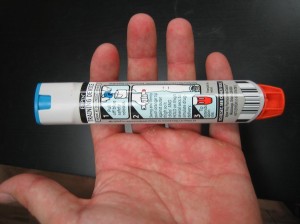Epinephrine or adrenaline has been considered as the most effective treatment for anaphylactic shock which is a life-threatening condition triggered by a severe allergic reaction. Always remember that only epinephrine can facilitate the opening up of the bronchial tubes in the lungs to restore breathing or even resuscitate the heart if it has stopped beating. As a life-threatening condition, being familiar with the measures to take is a must. By enrolling in a first aid class, you will learn how to properly deal with allergies.
Acquire an epinephrine kit from your doctor
The doctor can prescribe the individual with an epinephrine kit that can be used to treat anaphylactic shock once it occurs. Most of these kits include a combination of syringes and epinephrine or an EpiPen which is a small-sized injection that contains a pre-measured amount of epinephrine. The individual must keep the epinephrine kit close by every time he/she leaves the house or in cases where he/she could not control the immediate environment.
Teaching others how to use an epinephrine kit
The individual must teach family members and friends on how to treat anaphylactic shock using the epinephrine kit. They must be trained on how to recognize the early symptoms of an anaphylactic shock such as fainting or dizziness, hives, difficulty breathing and gastrointestinal discomfort. Additionally, the individual must also inform colleagues at work, family and friends regarding the specific allergen triggers. In doing so, the medical team can be informed regarding the condition in case of an anaphylactic shock.
Timely medical treatment
Even though using an EpiPen can help delay the effects of an anaphylactic shock, the individual still requires medical care at the hospital. Take note that even if the individual starts to feel better, he/she might still require more doses of epinephrine along with oral steroids and antihistamines in order to treat and recover from the reaction.
Care at the hospital

Once the individual is taken to the hospital, he/she will be given epinephrine treatment upon arrival. The individual might stay at the hospital for 1-2 days after an episode of anaphylactic shock while the body stabilizes. Additionally, further tests are carried out on the allergens that triggered the reaction.
Follow-up appointment
The doctor will usually schedule a follow-up visit in order to determine if the epinephrine kit was essential in saving the life of the individual or if there are adjustments to be made. Most of the epinephrine delivery systems are readily available to individuals who are prone to severe allergic reactions. Some try several types in order to find out the right one for them.
Considerations to bear in mind
If you have heard about inhalers that dispense epinephrine orally, they have been removed from the market since they are unable to deliver steady doses when required. There are new versions of inhalers being tested but it is still best to stick with the tested and proven EpiPen that has been used throughout the years.
